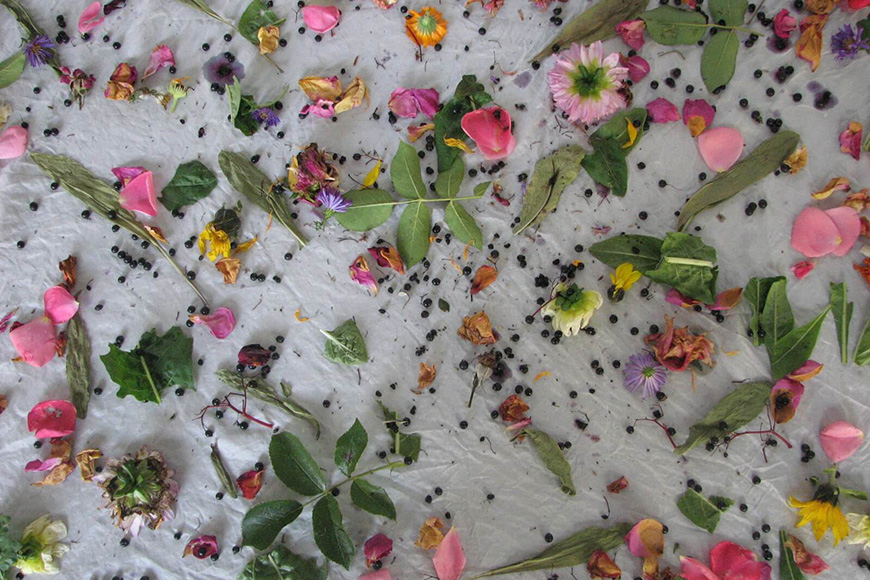Charlotte Turner, Research Assistant at LCF’s Centre for Sustainable Fashion has been exploring ways in which we can reduce the environmental impact of our clothes for years. Here Charlotte shares her views on emerging fabric dying processes that would have a positive impact on waste and contamination.
For several years now I’ve been exploring ways we can reduce the environmental impact of our clothes, primarily through the choice and use of materials and processes we use. A key area that has emerged within this research has been the way we dye fabrics, which can have huge impacts on water systems through waste and contamination – not to mention the fact that colour is such a hugely important aspect of fashion. I’ve found that there are many traditional and newly developed options currently being used and researched, both in the commercial industry, and in more academic arenas – and many by people I’ve met and worked with through the Centre for Sustainable Fashion and the Future Fabrics Expo, an annual London showcase of high quality and desirable sustainable materials for fashion.
One project currently of interest to me is the PhD research in to natural digital dyeing by Silvana Beatriz Palacios Guberti, a Fellow of the Royal Society of Edinburgh and Scottish Enterprise, who is developing ways to digitally print natural fabrics using natural dyes, vastly reducing waste and chemical input. This is an emerging project which I envision could have a huge impact on the industry, and the ways we currently work.
Closer to home, there are plenty of engaging projects emerging related to dyeing, both from LCF students and staff, so I wanted to highlight some of the most exciting ones.
Most recently, MA Fashion Futures student Susie Wareham’s natural dyes project was showcased in the Voice for Change exhibition curated by CSF’s Camilla Palestra and Dilys Williams. Susie explained that she uses natural dyes as a vehicle for change, running workshops using locally foraged plants to illustrate the dyeing process, while connecting people to their environment. In 2014 she was awarded a Silver Gilt medal at BBC Gardeners’ World Live 2014 for her garden Dyes of Yesterday, Colours of Tomorrow, where she designed and created a garden made of plants that were used for dyeing fabric before the use of synthetic dyes began in 1856. Susie explained “I…looked into the history of natural dyes in Birmingham and its industrial past. The design came from a map of Birmingham in 1731. A street runs through the garden in the form of red basil which also represents the canals of Birmingham and how the traditional fashion industry would have traded.”
Workshops of this type that can connect wearers to the source of their clothes have been proven to be a fantastic platform to explore dyeing techniques, and CSF member Katelyn Toth-Fejel has been running ‘Dinners to dye for’ for several years as part of Permacouture, a US based educational non-profit for regenerative design in fashion and textiles. These ‘dinners’ allow participants to explore the biodiversity of the plant based colour and taste palette, through a natural dyeing workshop, and multi-course meal made with the same colourful ingredients. This experience led her to create the invaluable and beautifully illustrated ‘Colour of Fashion Handbook’, a handbook for natural dyeing, and an essential introduction for students.
There are still even more projects emerging from London College of Fashion staff, including from MA Fashion and the Environment (MAFE) alumna Rachel Clowes. Rachel has been working on a range of projects related to the cultivation of natural dyes and fibres, including the recent Grow a Garment project with Seeds of Fashion, which culminated in a top being created with flax grown at LCF’s Mare Street and Cordwainers sites (recently featured in the Financial Times). Alongside this, Rachel coordinates the Dye Garden at Mare Street in Hackney, which was started by MAFE alumna Liz Spencer in collaboration with Kate Poland from Cordwainers Community Garden. The garden is cared for by students who plant and grow natural dyeing ingredients including woad (blue dye), weld (yellow), madder (red) and a variety of other dye plants. Students and staff can get involved, and then learn how to dye fabrics with their hand-harvested natural dyes. The dye garden has been recognised as a finalist in the 2014 Green Gown awards, and LCF has worked with the mental health charity MIND to involve volunteers in the gardens, as well as showcasing a dye garden Artisan Retreat installation at the Chelsea Flower Show in 2013. The success of this project led to a new dye garden being recently completed at LCF’s Lime Grove site, which is now being used by LCF and Chelsea students to grow natural dye plants.
Finally, another MA Fashion and the Environment alumni Thalia Warren developed a fantastic project which really illustrated the power of natural dyeing, and its potential place within the fashion industry. Thalia explained that her project had two aims: “to show that sustainable fashion using locally-sourced botanical dyes can be relevant and contemporary in today’s society; and to advocate that natural seasonal cycles, rather than industrial demands alone, can profitably inspire the rhythm of fashion.” That really sums up better than I can, the importance and relevance of exploring new (or old) ways of doing things.
More:
- Centre for Sustainable Fashion
- MA Fashion Futures
- Follow CSF on Twitter


